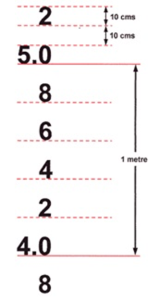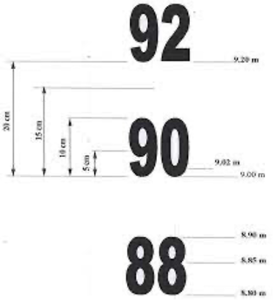Draft mark reading
Reading a ship’s draft marks accurately is essential to ensure the correct calculations of a draft survey.
Draft marks are found at 06 locations on a ship’s hull: fore, mid, and aft of both port and starboard sides, with a column of numbers running down the hull.
These numerals are draft markings and they are designed to be 10cm in height and 10cm apart, for example:
The unit for draft markings is always in meters (M), therefore the image above shows the marking range from 3.8m to 5.3m.
To begin reading the draft:
- Reading the whole number – this numeral is often times designed larger than other numerals.
- Reading the next digit – the bottom of any numeral corresponds to that numeral (usually an even number) while the top corresponds to the subsequent numbers (usually an odd number).
- Determining the final digit – As mentioned above, the numerals are exactly 10cm in height and apart, and while some ships may have indicator markings, often times a surveyor self-determines the final digit.
- As illustrated in the image, the draft reading taken was 9.02m
Tips:
- For draft marks away from berth (or if the vessel is at anchorage), a boat should be used so that surveyors are able to be close for accurate draft mark reading.
- In rough, choppy seas with strong waves, a draft reading tube could be used to limit the effects of waves. Currently, there are laser-pointed tubes, floating tubes, and periscopes which are also reliable alternatives for draft mark reading.
 |
 |
 |











